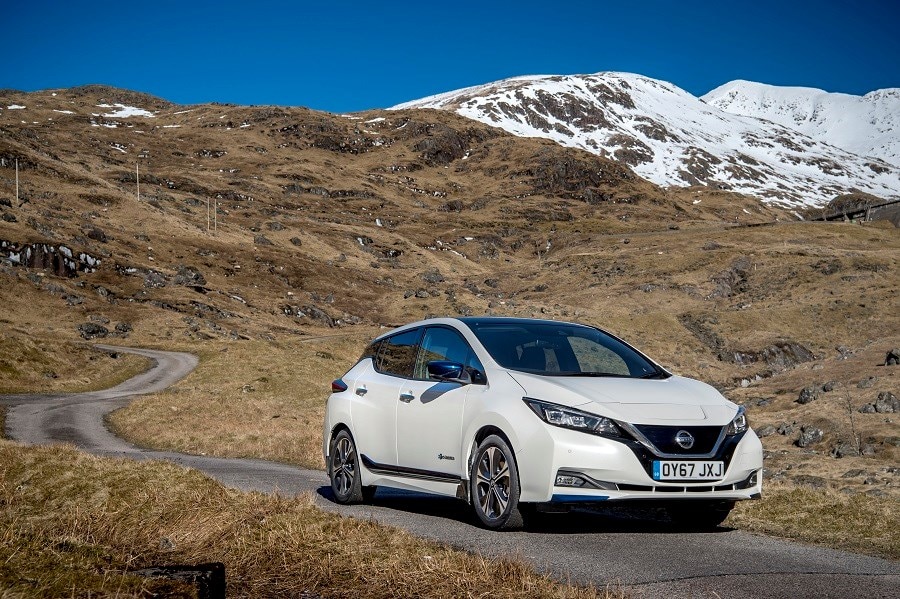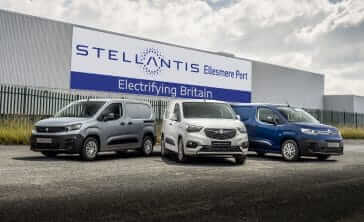Model Review
When the original Nissan Leaf debuted in 2009, it certainly didn’t invent the electric car sector, but it succeeded in bringing affordable electric motoring to the masses.
Since its unveil, the Leaf has been the world’s best-selling EV, and it still holds that mantle, with Nissan celebrating 400,000 Leaf sales in March 2019; it was the first electric car to reach the milestone.
The Leaf is a UK-built model, manufactured at Nissan’s Sunderland plant alongside the Juke, Qashqai and selected Infiniti models.
At launch, it offered an electric range of around 100 miles, which was impressive for the time, given the diminutive nature of its batteries relative to the larger packs fitted to modern EVs.
An updated model went on sale in 2013, which increased the electric range to 124 mile and allowed the Leaf to be charged faster using a rapid electric charger. The update also saw an increase in interior space.
Meanwhile, from 2015, the Leaf was offered with a larger 30kWh battery pack (the standard car’s is 24kWh), which enabled a range of 155 miles.
Latest model
Nissan unveiled an all-new second-generation Leaf in September 2017, which promises a much-improved electric range of up 242 miles (although a more realistic 168-mile range is given for ordinary driving conditions).
Nissan has ramped up the technology offered, too, with the Leaf being the first European model offered with ‘ProPilot’; this advanced adaptive cruise control system can drive semi-autonomously, and also has the capability to park itself without any driver involvement.
Another highlight of the new Leaf is the new ‘e-Pedal’, a regenerative braking system that allows you to control your speed with just one foot. As soon as you lift off the accelerator, the car brakes, allowing for a more seamless driving experience.
It also looks quite different to the model it replaces, with a new ‘V-motion’ grille, signature lighting and two-tone roof, giving it a far more modern look than the car it replaces.
More recently, Nissan has offered the Leaf with an even more powerful battery pack — a 62kWh unit — in a variant known as the ‘E+’. It offers an improved electric range of up to 239 miles, and has now been added as a permanent addition to the range-topping Tekna trim following a successful spell as a special edition model.
Another new trim— the 3.Zero, adds a larger eight-inch touchscreen with improved connectivity, which aims to improve on the outdated graphics provided in the standard car.
Value for money
As with the original Leaf, Nissan has ensured that its EV remains an affordable choice, although prices have risen with the latest update to accommodate the increased amount of tech fitted to the car.
Prices start from £27,995 for the entry-level Leaf, although it comes as standard with automatic lights, wipers, and a seven-inch touchscreen with Apple CarPlay and Android Auto. It also comes with the Safety Shield pack, which includes autonomous emergency braking, lane-keep assist and high beam assist to name but a few features. It’s still more expensive than a comparable petrol or diesel model, but the gap is certainly getting narrower. It’s also worth remembering that the government offers an incentive of £3,500 towards all EVs.
On the used market, the Leaf is available little as £6,000, which is a bargain considering how cheap it will be to run. You should be aware that first-generation Leafs came with the option of owning or leasing the battery – the latter option existed to make the initial price cheaper, although you have to pay between £55 and £75 per month to lease the battery, depending on your mileage.
Examples whose batteries were purchased outright when new are therefore more expensive; you can expect to pay around £1,500 for examples that don’t require the lease. More desirable 30kWh cars with a longer range start from around £12,500.
High demand for the current-generation Leaf has helped keep used values high, with the cheapest nearly-new examples starting at £23,000, which isn’t too much of a discount when you consider the £3,500 discount offered on brand new cars. With that said, buying a Leaf on the used market will mean beating the waiting list and benefitting from a small but welcome saving.
Looks and image
The last Leaf was an inoffensive-looking model, but it certainly wasn’t the last word in style. The second-generation car is certainly an improvement, but it’s still quite bland to look at, in our opinion.
That said, the new V-motion front end – similar to that of the Qashqai and Juke – brings a certain edge to the model, as do LED daytime running lights and rear lights. Tekna models also benefit from LED headlights. Overall, the Leaf offers understated electric motoring, which will appeal to many.
For all the advancements that came in the new Leaf, the interior is somewhat lacking in flair, with none of the tech or modern feel you find on rivals. All models minus the discontinued Visia trim come with a standard seven-inch touchscreen, which offers Apple CarPlay and Android Auto, a reversing camera, Bluetooth and DAB radio. It’s worth noting that the graphics on this touchscreen are out-dated, and it’s not particularly intuitive to use. The larger eight-inch screen fitted to ‘3.Zero’ models should amend this.
The interior quality is also a mixed bag, with plenty of soft touch materials offset by some rather cheap and scratchy plastics. It feels sturdy, though.
The Leaf is effortless to drive, with swift performance delivered from its torquey electric motor, allowing for a 0-60mph dash in under eight seconds. It’s not designed to be a sports model, but it feels rapid in comparison to other hatchbacks with similar power outputs. It’s also relaxed and comfortable to drive, although the suspension is a bit too firm but as with many EVs, this setup is necessary due to the additional weight of the batteries.
The aforementioned e-Pedal is also a fantastic feature of the Leaf. It allows you to just use the accelerator for both speeding up and slowing down courtesy of a regenerative braking system. It can take some time to get used to, and drivers who don’t like also have the option to turn it off. It’s ideal for commuting, too, particularly in slow-moving traffic where the Pro Pilot-fitted Tekna version can drive semi-autonomously.
Space and practicality
Past EVs—including the original Leaf—have always struggled where practicality is concerned, thanks to batteries taking up a chunk of the boot. However, with the second-generation Leaf growing in size, this is no longer an issue.
Adults will be able to sit comfortably in the rear seats, which are nice and supportive. There’s a decent amount of headroom and legroom, although the positioning of the batteries means you sit a bit higher than you might expect. Interior storage could also be better, with the Leaf lacking the flexibility of rivals such as the Hyundai Kona Electric.
But boot space is where the Leaf has a key advantage over rivals, with the Nissan’s boot offering 435 litres of space, which is large not only in the EV sector, but among traditional hatchbacks also.
It’s worth remembering that carrying the charging cables around with you will eat into the boot space slightly. In addition, the Bose sound system fitted to Tekna grade cars sits in the boot, and looks like a bit of an afterthought as a result.
The Leaf also has an impressive safety record, scoring a five star rating when tested by Euro NCAP. It was hardly surprising given Nissan’s excellent record in this area, as well as the fact that it comes as standard with the Safety Shield package. The package includes autonomous emergency braking, lane-keep assist, lane departure warning, rear cross traffic alert and high beam assist.
Power and range
The Leaf is offered with two battery packs of 40 and 62kWh respectively.
The standard pack is the 40kWh one, which produces 148bhp and is able to accelerate from 0-60mph in 7.7 seconds. It will continue on to a top speed of 90mph. Nissan claims a real-world range of 168 miles for this battery pack. As for charging times, it can be topped up from 20 to 80 per cent in one hour using a rapid charger, or seven and a half hours if you use a wall box.
For those wanting extra performance and a longer electric range, there is the Leaf E+ Tekna, which is now a permanent fixture in the Leaf range. Its larger 62kWh battery means it can travel a claimed 239 miles, while it can accelerate from 0-60mph in 7.1 seconds; this is marginally quicker than the standard model. Charging times were not available at the time of writing.
Running costs
While you might pay a premium for an EV over traditional petrol and diesel models, it’s easy to recuperate that money over time courtesy of low running costs.
The Leaf—as with all electric cars—offers zero emissions motoring. This means that it is exempt from London’s Congestion Charge, and as more cities are looking to ban high-polluting cars from certain areas, it’s good to know that the Leaf will not be ring-fenced by these policies.
A longer electric range (particularly on the E+ version) also means more time between charges for drivers covering long distances. It does still trail behind the Hyundai Kona Electric and Kia e-Niro in this respect, with those two cars managing 282 and 279 miles respectively.
The standard Leaf sits in insurance group 21, with the groupings for the E+ still to be confirmed.
Things to look out for
Many might worry about the reliability of an EV, but because they typically use fewer parts than a petrol or diesel car, there is less to go wrong. The Leaf has proven to be a dependable choice, but you should be aware that consistent usage over a significant period of time will ultimately make the battery less likely to hold charge, and it will not be capable of its originally stated range. If the battery eventually becomes inadequate, they are expensive to replace.
Rivals
At launch in 2011, the Leaf had the EV market to itself, at least in regards to cars of a similar size. Since then, though, significant competition has emerged. Key models in this class include the BMW i3, Volkswagen e-Golf, Renault Zoe, Hyundai Ioniq Electric, Hyundai Kona Electric, Kia Soul EV and Kia e-Niro, all of which are highly credible EVs you should consider.
Many more EVs are expected to be on the roads in the coming years.
Depreciation
First-generation Leafs are fantastic value for money, with prices starting from around £6,000, making it one of the cheapest ways to own an EV. Nearly-new examples are holding their value well—no doubt helped by the high demand for the model—although small savings can still be had.





